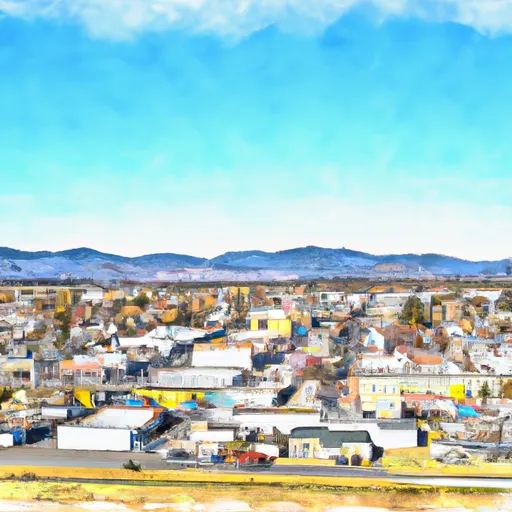-
 Snoflo Premium
Snoflo Premium
Get unlimited access to all our content
With no Ad interruptions! - Start Your Free Trial Login with existing account
Susanville
Eden Index
Climate
6.7
•
Recreation
4.0
•
Community
1.9
•
Safeguard
4.5/10

Susanville is a scenic city located in Lassen County, California. The region experiences a semi-arid climate, characterized by hot, dry summers and cold, snowy winters. Summers see average temperatures ranging from the mid-80s to low 90s Fahrenheit, while winter temperatures can drop below freezing. Precipitation is relatively low, with an annual average of around 13 inches, most of which falls in the form of snow during the winter months.
Hydrologically, Susanville is situated near the Susan River, which provides a beautiful backdrop for outdoor enthusiasts. The river supports a diverse range of aquatic life and offers excellent fishing opportunities for trout, bass, and steelhead. Visitors can also enjoy kayaking, canoeing, and rafting on its gentle rapids.
The surrounding landscape of Susanville showcases a variety of outdoor recreational activities. Lassen National Forest, located nearby, provides ample opportunities for hiking, biking, and camping amidst picturesque alpine scenery. The area is also renowned for its excellent birdwatching, with numerous species of migratory and resident birds that can be spotted throughout the year.
In summary, Susanville offers a semi-arid climate with hot summers and snowy winters. The city is blessed with the presence of the Susan River, providing excellent fishing and water-based activities. The surrounding area boasts opportunities for hiking, camping, and birdwatching, making it an ideal destination for outdoor enthusiasts.
What is the Eden Index?
The Snoflo Eden Index serves as a comprehensive rating system for regions, evaluating their desirability through a holistic assessment of climate health, outdoor recreation opportunities, and natural disaster risk, acknowledging the profound impact of these factors on livability and well-being.
Climate Health Indicator (CHI): 6.7
Susanville receives approximately
647mm of rain per year,
with humidity levels near 86%
and air temperatures averaging around
7°C.
Susanville has a plant hardyness factor of
7, meaning
plants and agriculture in this region tend to thrive during the non-winter months.
By considering the ideal temperature range, reliable water supplies, clean air, and stable seasonal rain or snowpacks, the Climate Health Indicator (CHI) underscores the significance of a healthy climate as the foundation for quality living.
A healthy climate is paramount for ensuring a high quality of life and livability in a region, fostering both physical well-being and environmental harmony. This can be characterized by ideal temperatures, reliable access to water supplies, clean air, and consistent seasonal rain or snowpacks.
Weather Forecast
Streamflow Conditions
North Lahontan
Area Rivers
North Lahontan
Snowpack Depths
North Lahontan
Reservoir Storage Capacity
North Lahontan
Groundwater Levels
Recreational Opportunity Index (ROI): 4.0
The Recreational Opportunity Index (ROI) recognizes the value of outdoor recreational options, such as parks, hiking trails, camping sites, and fishing spots, while acknowledging that climate plays a pivotal role in ensuring the comfort and consistency of these experiences.
Access to outdoor recreational opportunities, encompassing activities such as parks, hiking, camping, and fishing, is crucial for overall well-being, and the climate plays a pivotal role in enabling and enhancing these experiences, ensuring that individuals can engage in nature-based activities comfortably and consistently.
Camping Areas
| Campground | Campsites | Reservations | Toilets | Showers | Elevation |
|---|---|---|---|---|---|
| Rocky Point Dispersed - Eagle Lake | None | 5,117 ft | |||
| North Eagle Lake | 20 | 5,148 ft | |||
| Eagle | 50 | 5,134 ft | |||
| Taylorsville County Park | 200 | 3,542 ft | |||
| Long Point | 38 | 5,043 ft | |||
| Christie | 69 | 5,126 ft | |||
| Goumaz | 6 | 5,190 ft | |||
| Merrill | 183 | 5,120 ft | |||
| Roxie Peconom | 10 | 4,997 ft |
Nearby Fishing
Nearby Ski Areas
Catastrophe Safeguard Index (CSI):
The Catastrophe Safeguard Index (CSI) recognizes that natural disaster risk, encompassing floods, fires, hurricanes, and tornadoes, can drastically affect safety and the overall appeal of an area.
The level of natural disaster risk in a region significantly affects safety and the overall livability, with climate change amplifying these risks by potentially increasing the frequency and intensity of events like floods, fires, hurricanes, and tornadoes, thereby posing substantial challenges to community resilience and well-being.
Community Resilience Indicator (CRI): 1.9
The Community Resilience Indicator (CRI) recognizes that education, healthcare, and socioeconomics are crucial to the well-being of a region. The CRI acknowledges the profound impact of these elements on residents' overall quality of life. By evaluating educational resources, healthcare accessibility, and economic inclusivity, the index captures the essential aspects that contribute to a thriving community, fostering resident satisfaction, equity, and social cohesion.

